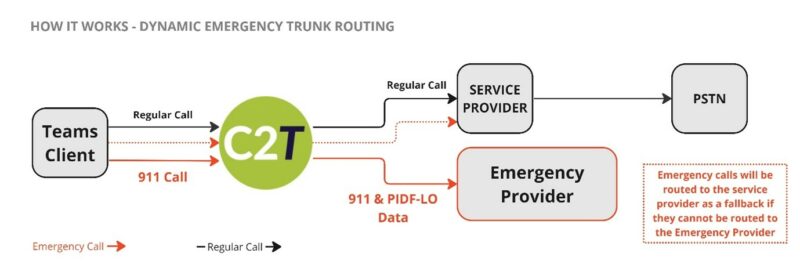Since early last year, compliance with Enhanced 911 (E911) has been enforced as part of the Ray Baum’s Act. The Act essentially called for dynamic location information to be passed through in an emergency situation as it was “necessary to adequately identify location of [the] calling party”.
Information such as street address, building, floor, suite or room number, otherwise known as PIDF-LO (Presence Information Data Format Location Object) data, would need to be provided. This posed an immediate issue as many standard telephony architectures cannot handle PIDF-LO data. Our DET solution for Microsoft Teams was first developed to solve this issue, which originally enabled efficient and easy emergency call routing for our Call2Teams PBX users.
Now, in addition to our existing PBX solution, we have refined our feature to allow DET provisioning for Trunks, allowing Trunk users to also route emergency calls and meet regulatory compliance. But what makes DET so important? How does it work? And why is our complete trunking solution so significant?
The Importance of Dynamic Emergency Trunking
Since it’s enforcement, the Ray Baum’s Act has seen a lot of businesses and providers scrambling to remain compliant. Some of the challenges created by the act include:
- Shifts in regulatory compliance for work-from-anywhere business structures
- New and complex integrations for businesses of all sizes
- Dynamic location routing solutions and additional provisioning of network elements like WIFI access points, with a dispatchable location required for dynamic/nomadic users
- Dispatch complications and delays
DET from Call2Teams is a unique, efficient, and reliable solution to help Service Providers and businesses navigate these obstacles. In brief, it allows for calls and vital location data to be passed directly from the Teams Client to Emergency Routing Service Providers (ERSPs).
How DET works
Before DET, emergency calls were routed out of Teams, through Call2Teams, through the upstream PBX/Trunk Service Provider, and then onwards to the emergency services. But, as previously mentioned, DET for Call2Teams simply passes all required data directly to the ERSP.

Because data is passed directly to the ERSPs, DET:
- Enables compliance with local legislation around emergency call and location provisioning.
- Removes the need for direct ERS capability management.
- Removes the need for the PBX or Trunk service to consume PIDF-LO data.
Why our DET for Trunks Solution is so Significant
It is clear to see how being feature complete is a massive advantage and Call2Teams can now be considered a full solution for all partner bases, regardless of configuration. With our ability to cater to Trunk users and our unique ‘click of a button’ setup process, we are unrivaled.
DET for Call2Teams allows for true emergency calling compliance in Teams for both PBX and Trunks users – it is the only complete offering available amongst its competitors. Not only is our solution unique, it is also widely compatible. DET has full interoperability with the most commonly used and trusted Emergency Routing Service Providers (ERSPs), including Bandwidth and Intrado.
Our DET solution has been designed to be highly scalable. Full compliance is delivered in accordance with your needs.
In addition to the simple, low monthly payments, we are completely partner focused. We offer dedicated support, ensuring you correctly provision, from discovery call to final DET setup.
Even though compliance has only been enforced since last year, we are already seeing how DET is making a big difference. One of our vendors recently reached out to us and said that “DET has made routing E911 calls from the MS Phone System through to my Emergency Response Service Provider a simple experience without the need of development on our own phone system to consume these type of phone calls as Call2Teams does that for us”.